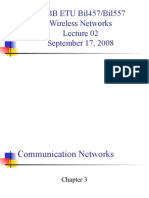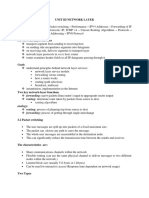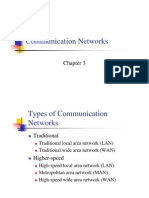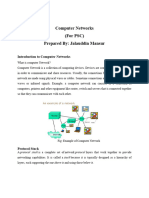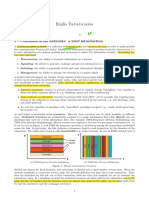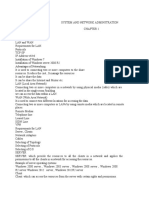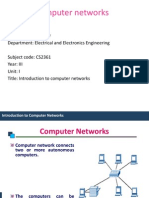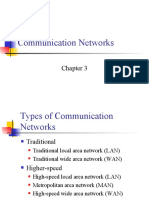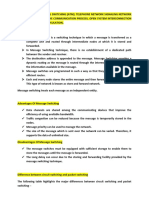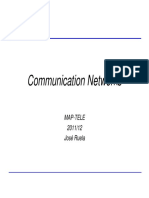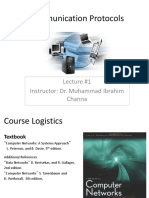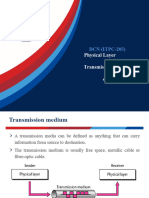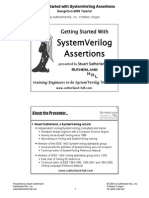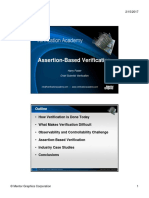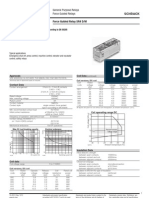EETS 8316 Wireless Networks
Fall 2012 Lecture: Networking Basics & Wireless
http://lyle.smu.edu/~skangude/eets8316.html
Shantanu Kangude
skangude@lyle.smu.edu
�A similar course at CMU
http://www.cs.cmu.edu/~prs/wirelessS12/
Inspiration for some of our slides besides the textbook
�Packet Switching & Virtual Circuits
�Switched Network
�Observations of Figure 3.3
Some nodes connect only to other nodes (e.g., 5 and 7) Some nodes connect to one or more stations Node-station links usually dedicated point-topoint links Node-node links usually multiplexed links
Frequency-division multiplexing (FDM) Time-division multiplexing (TDM)
Not a direct link between every node pair
�Techniques Used in Switched Networks
Circuit switching
Dedicated communications path between two stations E.g., public telephone network
Packet switching
Message is broken into a series of packets Each node determines next leg of transmission for each packet
�Phases of Circuit Switching
Circuit establishment
An end to end circuit is established through switching nodes
Information Transfer
Information transmitted through the network Data may be analog voice, digitized voice, or binary data
Circuit disconnect
Circuit is terminated Each node deallocates dedicated resources
�Characteristics of Circuit Switching
Can be inefficient
Channel capacity dedicated for duration of connection Utilization not 100% Delay prior to signal transfer for establishment
Once established, network is transparent to users Information transmitted at fixed data rate with only propagation delay
�Components of Public Telecommunications Network
Subscribers - devices that attach to the network; mostly telephones Subscriber line - link between subscriber and network
Also called subscriber loop or local loop
Exchanges - switching centers in the network
A switching centers that support subscribers is an end office
Trunks - branches between exchanges
�How Packet Switching Works
Data is transmitted in blocks, called packets Before sending, the message is broken into a series of packets
Typical packet length is 1000 octets (bytes) Packets consists of a portion of data plus a packet header that includes control information
At each node en route, packet is received, stored briefly and passed to the next node
�Packet Switching
�Packet Switching
�Packet Switching Advantages
Line efficiency is greater
Many packets over time can dynamically share the same node to node link
Packet-switching networks can carry out data-rate conversion
Two stations with different data rates can exchange information
Unlike circuit-switching networks that block calls when traffic is heavy, packet-switching still accepts packets, but with increased delivery delay Priorities can be used
�Disadvantages of Packet Switching
Each packet switching node introduces a delay Overall packet delay can vary substantially
This is referred to as jitter Caused by differing packet sizes, routes taken and varying delay in the switches
Each packet requires overhead information
Includes destination and sequencing information Reduces communication capacity
More processing required at each node
�Packet Switching Networks Datagram
Each packet treated independently, without reference to previous packets Each node chooses next node on packets path Packets dont necessarily follow same route and may arrive out of sequence Exit node restores packets to original order Responsibility of exit node or destination to detect loss of packet and how to recover
�Packet Switching Networks Datagram
Advantages:
Call setup phase is avoided Because its more primitive, its more flexible Datagram delivery is more reliable
�Packet Switching Networks Virtual Circuit
Preplanned route established before packets sent All packets between source and destination follow this route Routing decision not required by nodes for each packet Emulates a circuit in a circuit switching network but is not a dedicated path
Packets still buffered at each node and queued for output over a line
�Packet Switching Networks Virtual Circuit
Advantages:
Packets arrive in original order Packets arrive correctly Packets transmitted more rapidly without routing decisions made at each node
�Effect of Packet Size on Transmission
�Effect of Packet Size on Transmission
Breaking up packets decreases transmission time because transmission is allowed to overlap Figure 3.9a
Entire message (40 octets) + header information (3 octets) sent at once Transmission time: 129 octet-times
Figure 3.9b
Message broken into 2 packets (20 octets) + header (3 octets) Transmission time: 92 octet-times
�Effect of Packet Size on Transmission
Figure 3.9c
Message broken into 5 packets (8 octets) + header (3 octets) Transmission time: 77 octet-times
Figure 3.9d
Making the packets too small, transmission time starts increases Each packet requires a fixed header; the more packets, the more headers
�Network Protocols
�Key Features of a Protocol
Syntax
Concerns the format of the data blocks
Semantics
Includes control information for coordination and error handling
Timing
Includes speed matching and sequencing
�Agents Involved in Communication
Applications
Exchange data between computers (e.g., electronic mail)
Computers
Connected to networks
Networks
Transfers data from one computer to another
�TCP/IP Layers
Physical layer Network access layer Internet layer Host-to-host, or transport layer Application layer
�TCP/IP Physical Layer
Covers the physical interface between a data transmission device and a transmission medium or network Physical layer specifies:
Characteristics of the transmission medium The nature of the signals The data rate Other related matters
�TCP/IP Network Access Layer
Concerned with the exchange of data between an end system and the network to which it's attached Software used depends on type of network
Circuit switching Packet switching (e.g., X.25) LANs (e.g., Ethernet) Others
�TCP/IP Internet Layer
Uses internet protocol (IP) Provides routing functions to allow data to traverse multiple interconnected networks Implemented in end systems and routers
�TCP/IP Host-to-Host, or Transport Layer
Commonly uses transmission control protocol (tcp) Provides reliability during data exchange
Completeness Order
�TCP/IP Application Layer
Logic supports user applications Uses separate modules that are peculiar to each different type of application
�Protocol Data Units (PDUs)
�Common TCP/IP Applications
Simple mail transfer protocol (SMTP)
Provides a basic electronic mail facility
File Transfer Protocol (FTP)
Allows files to be sent from one system to another
TELNET
Provides a remote logon capability
HTTP
Web Browsing
�Comparison of OSI and TCP/IP
�TCP/IP Architecture Dominance
TCP/IP protocols matured quicker than similar OSI protocols
When the need for interoperability across networks was recognized, only TCP/IP was available and ready to go
OSI model is unnecessarily complex
Accomplishes in seven layers what TCP/IP does with fewer layers
�Internetworking Terms
Communication network facility that provides a data transfer service among devices attached to the network Internet collection of communication networks, interconnected by bridges/routers Intranet internet used by an organization for internal purposes
Provides key Internet applications Can exist as an isolated, self-contained internet
�Internetworking Terms
End System (ES) device used to support end-user applications or services Intermediate System (IS) device used to connect two networks Bridge an IS used to connect two LANs that use similar LAN protocols Router - an IS used to connect two networks that may or may not be similar
�Functions of a Router
Provide a link between networks Provide for the routing and delivery of data between processes on end systems attached to different networks Provide these functions in such a way as not to require modifications of the networking architecture of any of the attached subnetworks
�Network Differences Routers Must Accommodate
Addressing schemes
Different schemes for assigning addresses
Maximum packet sizes
Different maximum packet sizes requires segmentation
Interfaces
Differing hardware and software interfaces
Reliability
Network may provide unreliable service
�Wireless Medium & Traditional Networking
�Wired and Wireless Links
Wired links
Constant Reliable Physically isolated Usually single path
Wireless links
Variable Error-prone Share the medium with each other and other external, uncontrolled sources like appliances Multi-paths with reflections, refraction, scattering etc.
�Wireless Physical Layer Issues (1)
Wired error rate 10^(-10) Wireless error rates vary and orders of magnitude worse Signal attenuates with distance and is affected by noise MORE in wireless
Reception depends on SINR = S/I+N (Signal to Interference & Noise Ratio) Redundancy from Modulation and coding schemes improves reception rates
Multipath fading issues when reflections present
�Wireless Physical Layer Issues (2)
Received power is too low compared to the transmit power
Received signal will always look like the transmitted signal Collision Detection as in Ethernet not possible ACKs/NACKs are usually the means to infer correct reception, losses, or collisions
�Wireless & MAC Layer Issues
Multiplexing and Multiple Access
TDMA, FDMA, CDMA, or randomly access a channel in time Even with TDMA, FDMA, and CDMA, the number of simultaneous channels available may be at-times LESS than the number of simultaneous potential transmitters
Use MAC protocols to share channels
Losses can be PHYSICAL layer based on MAC layer based collisions
�Adding Capacity in Wireless Networks
Not as simple as adding new wires Adding more links increase interference May need to use extra spectrum Or have Frequency Reuse (see cellular arch.)
Limit/Isolate signal power to certain physical areas Reuse the same frequencies in other areas
�Cellular Coverage Tiling and Frequency Reuse
Image Source: http://www.realwireless.biz/tag/cellular/
�Mobility Issues
Time Varying Channel Response, the way the channel modifies what is transmitted Even with stationary transmitters and receivers, the items in the channel may be mobile
Time varying channel response, again
Traditional routing and IP addressing are meant for not so frequently changing topologies and SUBNET MEMBERSHIP
�Making Networking Work for Wireless
Physical layer solutions to deal with signal propagation challenges
Use of redundancy in space, time, frequency domains, rate adaptation, dealing with multipath
MAC layer solutions to deal with challenges
ACKs and retransmissions, hidden terminals, power control mechanisms, Hybrid ARQs
Higher layer challenges
TCP congestion control issues, highly variable bandwidth links, dealing with disconnected operation IP address and routing when changing locations? Mobile IP
�Evaluating Wireless Protocols & Networks
�Evaluation Tools in Networking
Simulations
Simplistic & least accurate, but easy repeatable first analysis
Actual testbeds
Difficult and expensive to build and maintain Hard for repeatability
Emulators
Middle ground between Simulations and Testbeds
�Models Used in Wireless Evaluations
Reception area is circular (not really); better:
Grey areas where reception is probabilistic Interference, even beyond reception areas
The world is flat; no, earth is spherical 2 ray ground model 1 ray line of sight, the other reflecting from the ground All radios have equal range; not necessary If A can hear B, B can hear A; not necessary If I can hear you, I may not hear you perfectly Signal strength is not a simple function of distance model fading, transmit rate, terrain factors
�Summary
Basics of switching and networking Wireless challenges for traditional networking Wireless network evaluation strategies
